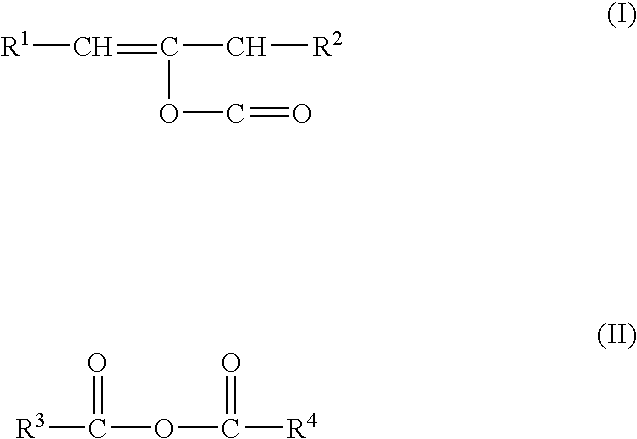Filler for papermaking process
a technology of papermaking process and filler, which is applied in the field of filler for papermaking process, can solve the problems of sizing loss in the final product, high consumption of sizing agent, and difficult size of cellulosic suspensions
- Summary
- Abstract
- Description
- Claims
- Application Information
AI Technical Summary
Problems solved by technology
Method used
Image
Examples
example 1
[0051] Fillers according to the invention and for comparison were prepared by treating calcium salt-containing material with cellulose derivatives. Cellulose derivatives used were carboxymethyl celluloses (“CMC”) having DSNI (DSCA=DSCM=DSA=DSNA=DSNI) of 0.3, 0.32 and 0.7, respectively. Another CMC used was quaternary ammonium carboxymethyl celluloses (“QN-CMC”) having DSCA=DSCM=DSA=0.4; DSC=DSQN=0.17; and DSNI=DSNA=0.4−0.17=0.23. The average molecular weights of the cellulose derivatives used were in the range of from 100,000 to 400,000. Calcium salt-containing materials used were different precipitated calcium carbonates (“PCC”) having a surface area of 5.7 and 10.0 m2 / g, respectively. Another calcium salt-containing material used was SuperFill® (PCC on pulp fines).
[0052] The fillers were prepared by dissolving CMC into water to a consistency of 0.5% by weight. Thereafter, the obtained CMC composition was added to PCC filler slurry and mixed during 25 to 45 minutes at a temperatur...
example 2
[0053] Sizing of paper produced according to the invention was evaluated and compared to paper used for comparison purposes. Paper according to the invention was produced using IP1 according to Example 1. Paper used for comparison was produced using CP1 according to Example 1 and using filler containing no cellulose derivative.
[0054] Paper sheets were produced from pulp consisting of chemical pulp and containing untreated PCC in varying amounts (% by weight, based on dry paper), as indicated in Table 1. To the pulp suspension was added 2.0 kg / tonne dry fibres of filler according to Example 1 and filler containing no cellulose derivative; 3.0 kg / tonne dry fibres of AKD (aqueous dispersion Eka Keydime C223), and a retention system comprising cationic starch (Eka PL 1510) and silica particles (Eka NP 780). Both the cationic starch and silica particles were added in an amount of 0.15 kg / tonne dry fibres. The addition sequence was as follows:
Addition of CMC-treated PCC: 0 sec.Addition...
example 3
[0056] In this Example, papermaking processes according to the invention were evaluated in which (i) CMC-treated PCC was added to the pulp suspension, and (ii) CMC and PCC (untreated) were separately added to the pulp suspension.
[0057] Paper sheets were produced from pulp of the same type used in Example 2 and containing 30% by weight, based on dry paper, of untreated PCC (surface area of 10 m2 / g) or CMC (DSNI 0.3)-treated PCC (10 m2 / g) (IP2 according to Example 1). To the pulp suspension was added 4 kg / tonne dry fibre of cationic starch (PB 970), 3.0 kg / tonne dry fibres of AKD (aqueous sizing dispersion Eka Keydime C223), and a retention system comprising cationic polyacrylamide (Eka PL 1310) and silica particles (Eka NP 780). Both the cationic polyacrylamide and silica particles were added in an amount of 0.20 kg / tonne dry paper. When untreated PCC was used, 1.0 kg / tonne of CMC having a DSNI of 0.3 was separately added. No separate addition of CMC was made when adding CMC-treated...
PUM
| Property | Measurement | Unit |
|---|---|---|
| thickness | aaaaa | aaaaa |
| length | aaaaa | aaaaa |
| molecular weight | aaaaa | aaaaa |
Abstract
Description
Claims
Application Information
 Login to View More
Login to View More - R&D
- Intellectual Property
- Life Sciences
- Materials
- Tech Scout
- Unparalleled Data Quality
- Higher Quality Content
- 60% Fewer Hallucinations
Browse by: Latest US Patents, China's latest patents, Technical Efficacy Thesaurus, Application Domain, Technology Topic, Popular Technical Reports.
© 2025 PatSnap. All rights reserved.Legal|Privacy policy|Modern Slavery Act Transparency Statement|Sitemap|About US| Contact US: help@patsnap.com

